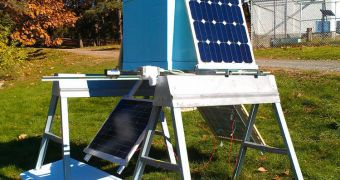Building 45 balloon science payloads is not an easy task, but one that is necessary if NASA is to get the most relevant results possible from its upcoming Radiation Belt Space Probes (RBSP) mission. The data the two RBSP spacecraft will collect will be augmented by a series of balloon-based studies.
These will be conducted above Antarctica, via the Balloon Array for RBSP Relativistic Electron Losses (BARREL). Multiple high-altitude balloons will be launched from near the South Pole, carrying the science payloads currently being developed at Dartmouth College in Hanover, New Hampshire.
The work is being carried out on the lab of associate professor of physics and astronomy Robyn Millan, the principal investigator for the BARREL mission. She and her team are responsible for assembling and testing 45 science suites for this endeavor.
Not all components are made at Dartmouth. Many are sent there from the University of California in Berkeley (UCB), University of California in Santa Cruz (UCSC) and University of Washington in Seattle (UWS). After they are assembled, they undergo a rigorous testing process.
“We've been drilling a lot of holes. My students figured out that we have almost 10,000 holes to drill,” the expert says. But their work will not be in vain. The data brought by these instruments will augment the readings collected by the two spacecraft making up the RBSP mission.
The satellites are scheduled to launch this August, and their main objective will be to study the two Van Allen radiation belts surrounding our planet. Each of these belts is made up of protons and electrons, which interact with each other, and with the rest of the atmosphere, in poorly-understood ways.
“We're both looking at the loss of particles from the radiation belts. RBSP sits in space near the equatorial plane and looks at the particles along magnetic field lines there,” Millan explains.
“These particles come into our atmosphere – following magnetic field lines to their base at the Poles – and produce X-rays BARREL measures those X-rays. Together we can combine measurements of the same set of particles,” she goes on to say.
The reason why understanding the Van Allen radiation belts is so important is because they have the potential to damage the sensitive electronics aboard vital satellites, such as those making up the Global Positioning System (GPS.)
“BARREL is a balloon-based Mission of Opportunity to augment the measurements of NASA's RBSP spacecraft. BARREL seeks to measure the precipitation of relativistic electrons from the radiation belts during two multi-balloon campaigns, operated in the southern hemispheres,” a NASA press release states.

 14 DAY TRIAL //
14 DAY TRIAL //